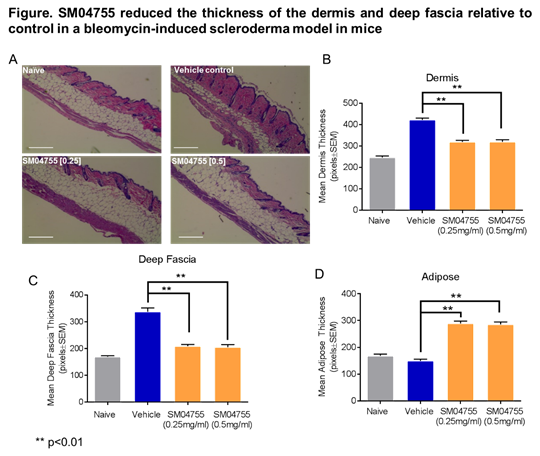Session Information
Session Type: ACR Poster Session B
Session Time: 9:00AM-11:00AM
Background/Purpose: Scleroderma is an autoimmune fibrotic disease, which presents skin manifestations among others. The Wnt pathway plays an important role in inflammation, skin fibrosis, and vasculopathy, and is upregulated in scleroderma. SM04755, a novel, topical, small-molecule Wnt pathway inhibitor was evaluated in a series of preclinical studies to determine its potential to reduce inflammation, dermal fibrosis, and vasculopathy, thereby improving skin health in scleroderma.
Methods: Wnt pathway inhibition of SM04755 was measured using a cell-based reporter assay. Anti-inflammatory activity was evaluated by measuring TNF-α and IL-6 secretion using ELISA in THP-1 monocytes stimulated with Lipopolysaccharides (LPS), and PBMCs stimulated with anti-CD3/anti-CD28. The effect on fibrosis was assessed in TGF-β stimulated human dermal fibroblasts by measuring smooth muscle actin (αSMA), plasminogen activator inhibitor (PAI-1), connective tissue growth factor (CTGF), and collagen expression by qPCR. The effect on myofibroblast differentiation and reversion was measured by immunocytochemistry for αSMA. Pharmacokinetics were evaluated following topical application in rats and mini-pigs by analysis of compound concentrations in skin and plasma. In vivo efficacy was evaluated in a subcutaneous bleomycin-induced mouse model of scleroderma by histological measurements of the thickness of various layers of the skin, and CD31 immunohistochemistry for vasculopathy.
Results: SM04755 demonstrated potent (EC50=152nM) and selective inhibition of Wnt signaling. SM04755 inhibited LPS and anti-CD3/anti-CD28 induced TNF-α and IL-6 secretion (EC50=500nM) in THP-1 cells and PBMCs. SM04755 treatment significantly (p<0.05) inhibited dermal fibrosis measured by a decrease in TGF-β stimulated αSMA, PAI-1, CTGF, and collagen gene expression in human dermal fibroblasts. SM04755 reduced αSMA stained stress fibers in myofibroblasts (EC50=400nM) thus reversing fibrosis. Single topical application of SM04755 showed skin concentrations >EC50 for >24hrs, with minimal systemic exposure or toxicity. In a bleomycin-induced mouse scleroderma model, topical SM04755 treatment after induction of fibrosis significantly (p<0.01) reduced thickness of dermis and deep fascia, and increased thickness of the adipose layer, as compared to vehicle, thereby reversing bleomycin-induced dermal fibrosis. SM04755 treatment also reduced vasculopathy measured as a decrease in the endothelial marker CD31 staining in the skin.
Conclusion: SM04755 inhibited inflammation and reversed dermal fibrosis in vitro. In a bleomycin-induced mouse scleroderma model, topically applied SM04755 reversed dermal fibrosis, increased adipose tissue, and reduced vasculopathy compared to vehicle, with minimal exposure in the plasma or systemic toxicity. SM04755 has potential as a topical therapy for scleroderma.
To cite this abstract in AMA style:
Deshmukh V, Hood A, Ibanez M, Dellamary L, Stewart J, Seo T, Hood J, Yazici Y. Discovery of a Small Molecule Inhibitor of the Wnt Pathway (SM04755) As a Potential Topical Treatment for Scleroderma [abstract]. Arthritis Rheumatol. 2016; 68 (suppl 10). https://acrabstracts.org/abstract/discovery-of-a-small-molecule-inhibitor-of-the-wnt-pathway-sm04755-as-a-potential-topical-treatment-for-scleroderma/. Accessed .« Back to 2016 ACR/ARHP Annual Meeting
ACR Meeting Abstracts - https://acrabstracts.org/abstract/discovery-of-a-small-molecule-inhibitor-of-the-wnt-pathway-sm04755-as-a-potential-topical-treatment-for-scleroderma/

